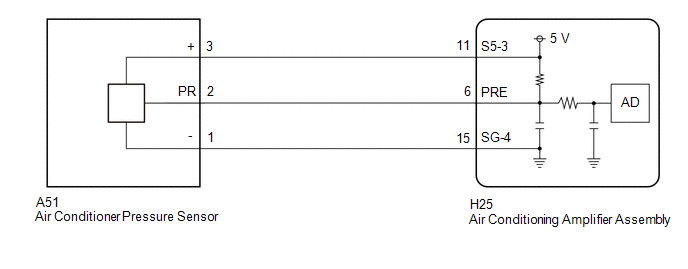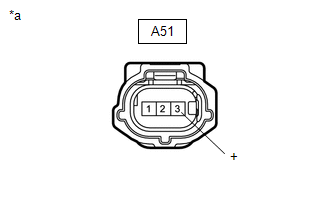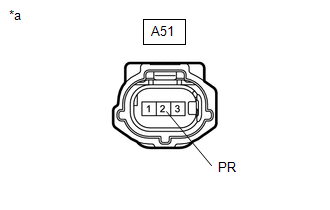Toyota Yaris: Air Conditioning System / Refrigerant Pressure Sensor Circuit Short to Ground (P053011)
DESCRIPTION
The air conditioner pressure sensor, which is installed to the high pressure side pipe to detect refrigerant pressure, sends a refrigerant pressure signal to the air conditioning amplifier assembly. The air conditioning amplifier assembly converts this signal to a pressure value according to the sensor characteristics and uses it to control the compressor.
| DTC No. | Detection Item | DTC Detection Condition | Trouble Area | Memory |
|---|---|---|---|---|
| P053011 | Refrigerant Pressure Sensor Circuit Short to Ground | Diagnosis Condition:
Malfunction Status:
Detection Time:
|
| Memorized |
WIRING DIAGRAM

PROCEDURE
| 1. | CHECK REFRIGERANT PRESSURE |
(a) Install a manifold gauge set.
(b) Read the Data List according to the display on the GTS.
Body Electrical > Air Conditioner > Data List| Tester Display | Measurement Item | Range | Normal Condition | Diagnostic Note |
|---|---|---|---|---|
| Regulator Pressure Sensor | Air conditioner pressure sensor | Min.: -32.768 MPaG Max.: 32.767 MPaG | Actual refrigerant pressure displayed |
|
| Tester Display |
|---|
| Regulator Pressure Sensor |
(c) Compare the values displayed in the Data List and on the manifold gauge set.
| Result | Proceed to |
|---|---|
| The values displayed in the Data List and on the manifold gauge set does not match | A |
| The values displayed in the Data List and on the manifold gauge set match | B |
| B |
 | INSPECT REFRIGERANT PRESSURE WITH MANIFOLD GAUGE SET |
|
| 2. | READ VALUE USING GTS (REGULATOR PRESSURE SENSOR) |
(a) Read the Data List according to the display on the GTS.
Body Electrical > Air Conditioner > Data List| Tester Display | Measurement Item | Range | Normal Condition | Diagnostic Note |
|---|---|---|---|---|
| Regulator Pressure Sensor | Air conditioner pressure sensor | Min.: -32.768 MPaG Max.: 32.767 MPaG | Actual refrigerant pressure displayed |
|
| Tester Display |
|---|
| Regulator Pressure Sensor |
OK:
Disconnecting the A51 connector of the air conditioner pressure sensor causes the Data List value to change.
| Result | Proceed to |
|---|---|
| Regulator pressure sensor value changes | A |
| Regulator pressure sensor value does not change | B |
| B |
 | GO TO STEP 5 |
|
| 3. | CHECK TERMINAL VOLTAGE (AIR CONDITIONER PRESSURE SENSOR) |
| (a) Measure the voltage according to the value(s) in the table below. Standard Voltage:
|
|
| OK |
 | REPLACE AIR CONDITIONER PRESSURE SENSOR |
|
| 4. | CHECK HARNESS AND CONNECTOR (AIR CONDITIONER PRESSURE SENSOR - AIR CONDITIONING AMPLIFIER ASSEMBLY) |
(a) Disconnect the H25 air conditioning amplifier assembly connector.
(b) Measure the resistance according to the value(s) in the table below.
Standard Resistance:
| Tester Connection | Condition | Specified Condition |
|---|---|---|
| A51-3 (+) - H25-11 (S5-3) | Always | Below 1 Ω |
| OK |
 | REPLACE AIR CONDITIONING AMPLIFIER ASSEMBLY |
| NG |
 | REPAIR OR REPLACE HARNESS OR CONNECTOR |
| 5. | CHECK TERMINAL VOLTAGE (AIR CONDITIONING AMPLIFIER ASSEMBLY) |
| (a) Measure the voltage according to the value(s) in the table below. Standard Voltage:
|
|
| OK |
 | REPLACE AIR CONDITIONING AMPLIFIER ASSEMBLY |
|
| 6. | CHECK HARNESS AND CONNECTOR (AIR CONDITIONER PRESSURE SENSOR - AIR CONDITIONING AMPLIFIER ASSEMBLY) |
(a) Disconnect the H25 air conditioning amplifier assembly connector.
(b) Measure the resistance according to the value(s) in the table below.
Standard Resistance:
| Tester Connection | Condition | Specified Condition |
|---|---|---|
| A51-2 (PR) or H25-6 (PRE) - Other terminals and body ground | Always | 10 kΩ or higher |
| OK |
 | REPLACE AIR CONDITIONING AMPLIFIER ASSEMBLY |
| NG |
 | REPAIR OR REPLACE HARNESS OR CONNECTOR |
 Ambient Temperature Sensor Circuit Short to Battery or Open (P007015)
Ambient Temperature Sensor Circuit Short to Battery or Open (P007015)
DESCRIPTION The thermistor assembly is installed in front of the cooler condenser assembly to detect the ambient temperature, which is used to control the air conditioning system...
 Refrigerant Pressure Sensor Circuit Short to Battery or Open (P053015)
Refrigerant Pressure Sensor Circuit Short to Battery or Open (P053015)
DESCRIPTION The air conditioner pressure sensor, which is installed to the high pressure side pipe to detect refrigerant pressure, sends a refrigerant pressure signal to the air conditioning amplifier assembly...
Other information:
Toyota Yaris XP210 (2020-2025) Reapir and Service Manual: Remote Up / Down Function does not Operate
DESCRIPTION When the ignition switch is ON, the multiplex network master switch assembly sends remote up and down signals to each door window regulator motor assembly via LIN communication. WIRING DIAGRAM CAUTION / NOTICE / HINT NOTICE: The power window control system uses the LIN communication system...
Toyota Yaris XP210 (2020-2025) Reapir and Service Manual: Diagnostic Trouble Code Chart
D..
Categories
- Manuals Home
- Toyota Yaris Owners Manual
- Toyota Yaris Service Manual
- Fuel Gauge
- Fuse Panel Description
- Opening and Closing the Liftgate/Trunk Lid
- New on site
- Most important about car
Break-In Period
No special break-in is necessary, but a few precautions in the first 600 miles (1,000 km) may add to the performance, economy, and life of the vehicle.
Do not race the engine. Do not maintain one constant speed, either slow or fast, for a long period of time. Do not drive constantly at full-throttle or high engine rpm for extended periods of time. Avoid unnecessary hard stops. Avoid full-throttle starts.





